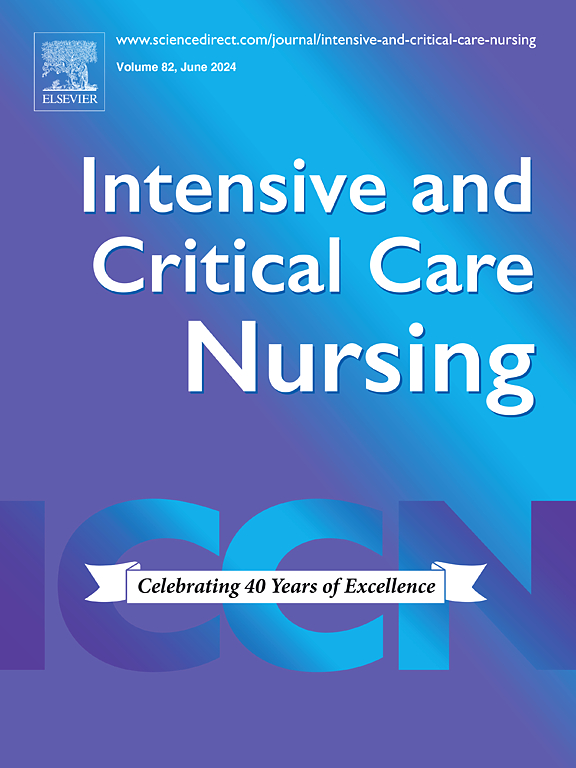结构化教育干预对危重患者眼表疾病预防的影响:一项非随机临床试验
IF 4.7
2区 医学
Q1 NURSING
引用次数: 0
摘要
眼表疾病(OSDs)在重症监护病房(ICU)患者中很常见,发病率从13.2%到59.4%不等。危险因素包括眼睑闭合受损、眨眼反射减少和全身炎症,镇静和机械通气会加重炎症。尽管存在这些风险,但ICU护士往往缺乏标准化的眼科护理培训,导致实践不一致和患者预后不佳。目的评价结构化教育干预对ICU护士危重患者眼部护理的影响。方法在西班牙某三级医院进行非随机临床试验,纳入161例ICU患者(干预前80例;需要≥48小时机械通气和镇静。该研究包括干预前观察阶段,随后是针对ICU护士的循证眼科护理的结构化教育计划,包括一小时的面对面会议,结合理论内容,床边演示和支持视觉材料的分发。使用卡方检验、t检验和逻辑回归分析临床结果和对护理方案的依从性。结果干预前OSDs发生率为76.3%,干预后为38.3% (p <;0.001)。干眼(40% - 9.9%)、眼lagophthalmos(43.8% - 19.8%)、红眼(38.8% - 12.3%)和眼水肿(48.8% - 29.6%)均显著降低。早期眼保健执行率从33.8%提高到71.6% (p <;0.001),循证护理方案的依从性从80%提高到93.8% (p <;0.01)。干预后护理与较低的OSD风险密切相关(调整OR: 0.21;95% ci: 0.11-0.43;p & lt;0.001)。结论:有组织的教育干预可显著降低osd的发生率,并提高对ICU环境中循证眼科护理实践的依从性。临床实践意义将循证眼科护理方案纳入ICU常规可降低OSD发生率并提高患者预后。护士培训和机构支持对于维持依从性、提高患者安全性和尽量减少危重患者可预防的眼部并发症至关重要。本文章由计算机程序翻译,如有差异,请以英文原文为准。
Impact of a structured educational intervention on the prevention of ocular surface disorders in critically ill patients: A non-randomized clinical trial
Introduction
Ocular surface disorders (OSDs) are common in intensive care unit (ICU) patients, with incidence rates ranging from 13.2% to 59.4%. Risk factors include impaired eyelid closure, reduced blink reflexes, and systemic inflammation, exacerbated by sedation and mechanical ventilation. Despite these risks, ICU nurses often lack standardized ocular care training, leading to inconsistent practices and suboptimal patient outcomes.
Aim
To evaluate the impact of a structured educational intervention on ICU nurses’ regarding ocular care in critically ill patients.
Method
A non-randomized clinical trial was conducted in a tertiary hospital in Spain, including 161 ICU patients (80 pre-intervention; 81 post-intervention) requiring ≥ 48-hour mechanical ventilation and sedation. The study involved a pre-intervention observational phase followed by a structured educational program for ICU nurses on evidence-based ocular care consisting of a one-hour in-person session combining theoretical content, bedside demonstration, and distribution of supporting visual materials. Clinical outcomes and adherence to care protocols were analysed using chi-square tests, t-tests, and logistic regression.
Results
The incidence of OSDs decreased from 76.3 % pre-intervention to 38.3 % post-intervention (p < 0.001). Significant reductions were observed in dry eye (40 % to 9.9 %), lagophthalmos (43.8 % to 19.8 %), red eye (38.8 % to 12.3 %), and ocular oedema (48.8 % to 29.6 %). Early ocular care implementation increased from 33.8 % to 71.6 % (p < 0.001), and adherence to evidence-based care protocols improved from 80 % to 93.8 % (p < 0.01). Post-intervention care was strongly associated with a lower OSD risk (adjusted OR: 0.21; 95 % CI: 0.11–0.43; p < 0.001).
Conclusion
A structured educational intervention significantly reduced the incidence of OSDs and improved adherence to evidence-based ocular care practices in ICU settings.
Implication for clinical practice
Integrating evidence-based ocular care protocols into ICU routines reduces OSD incidence and enhances patient outcomes. Nurses training and institutional support are essential for sustaining adherence, improving patient safety, and minimizing preventable ocular complications in critically ill patients.
求助全文
通过发布文献求助,成功后即可免费获取论文全文。
去求助
来源期刊

Intensive and Critical Care Nursing
NURSING-
CiteScore
6.30
自引率
15.10%
发文量
144
审稿时长
57 days
期刊介绍:
The aims of Intensive and Critical Care Nursing are to promote excellence of care of critically ill patients by specialist nurses and their professional colleagues; to provide an international and interdisciplinary forum for the publication, dissemination and exchange of research findings, experience and ideas; to develop and enhance the knowledge, skills, attitudes and creative thinking essential to good critical care nursing practice. The journal publishes reviews, updates and feature articles in addition to original papers and significant preliminary communications. Articles may deal with any part of practice including relevant clinical, research, educational, psychological and technological aspects.
 求助内容:
求助内容: 应助结果提醒方式:
应助结果提醒方式:


